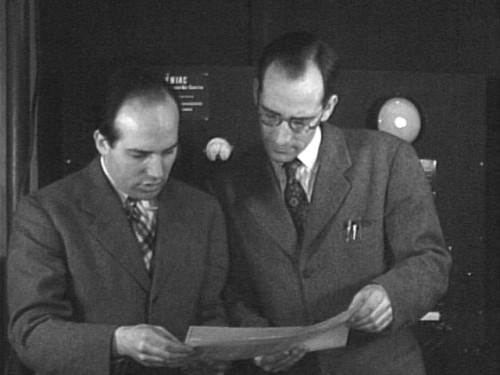|
J. Presper Eckert and John Mauchly
The Universal Automatic Computer or UNIVAC was a computer milestone achieved by Dr. Presper Eckert and Dr. John Mauchly, the team that invented the ENIAC computer.
J Presper Eckert and John Mauchly, after leaving the academic environment of The Moore School of Engineering to start their own computer business, found their first client was the United States Census Bureau. The Bureau needed a new computer to deal with the exploding U.S. population (the beginning of the famous baby boom). In April 1946, a $300,000 deposit was given to Eckert and Mauchly for the research into a new computer called the UNIVAC.
The research for the project proceeded badly, and it was not until 1948 that the actual design and contract was finalized. The Census Bureau's ceiling for the project was $400,000. J Presper Eckert and John Mauchly were prepared to absorb any overrun in costs in hopes of recouping from future service contracts, but the economics of the situation brought the inventors to the edge of bankruptcy.
In 1950, Eckert and Mauchly were bailed out of financial trouble by Remington Rand Inc. (manufacturers of electric razors), and the "Eckert-Mauchly Computer Corporation" became the "Univac Division of Remington Rand." Remington Rand's lawyers unsuccessfully tried to re-negotiate the government contract for additional money. Under threat of legal action, however, Remington Rand had no choice but to complete the UNIVAC at the original price.
On March 31, 1951, the Census Bureau accepted delivery of the first UNIVAC computer. The final cost of constructing the first UNIVAC was close to one million dollars. Forty-six UNIVAC computers were built for both government and business uses. Remington Rand became the first American manufacturers of a commercial computer system. Their first non-government contract was for General Electric's Appliance Park facility in Louisville, Kentucky, who used the UNIVAC computer for a payroll application.
J Presper Eckert and John Mauchly's UNIVAC was a direct competitor with IBM's computing equipment for the business market. The speed with which UNIVAC's magnetic tape could input data was faster than IBM's punch card technology, but it was not until the presidential election of 1952 that the public accepted the UNIVAC's abilities.
In a publicity stunt, the UNIVAC computer was used to predict the results of the Eisenhower-Stevenson presidential race. The computer had correctly predicted that Eisenhower would win, but the news media decided to blackout the computer's prediction and declared that the UNIVAC had been stumped. When the truth was revealed, it was considered amazing that a computer could do what political forecasters could not, and the UNIVAC quickly became a household name. The original UNIVAC now sits in the Smithsonian Institution.
UNIVAC Specifications
The UNIVAC had an add time of 120 microseconds, multiply time of 1,800 microseconds and a divide time of 3,600 microseconds.
Input consisted of magnetic tape with a speed of 12,800 characters per second with a read-in speed of 100 inches per second, records at 20 characters per inch, records at 50 characters per inch, card to tape converter 240 cards per minute, 80 column punched card input 120 characters per inch, and punched paper tape to magnetic tape converter 200 characters a second.
Output media/speed was magnetic tape/12,800 characters per second, uniprinter/10-11 characters per second, high speed printer/600 lines per minute, tape to card converter/120 cards per minute, Rad Lab buffer storage/Hg 3,500 microsecond, or 60 words per minute.
Historical Timeline for J. Presper Eckert and John Mauchly :
|
|

Click for a larger version
|










